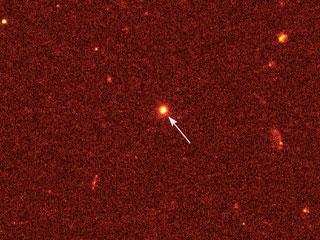
A visible-light image of GRB 110328A's host galaxy (arrow) taken by the Hubble Space Telescope's Wide Field Camera 3. The galaxy is 3.8 billion light-years away. Photo: NASA
WASHINGTON (AFP): NASA is studying a surprising cosmic burst at the centre of distant galaxy that has burned for more than a week, longer than astronomers have ever seen before, the US space agency said Thursday.
Calling it "one of the most puzzling cosmic blasts ever observed," NASA said it has mobilised the Hubble Space Telescope along with its Swift satellite and Chandra X-ray Observatory to study the phenomenon.
"More than a week later, high-energy radiation continues to brighten and fade from its location," NASA said in a statement.
"Astronomers say they have never seen such a bright, variable, high-energy, long-lasting burst before. Usually, gamma-ray bursts mark the destruction of a massive star, and flaring emission from these events never lasts more than a few hours."
The first in a series of explosions was detected by a NASA telescope on March 28 in the constellation Draco.
Astronomers think the blast occurred "when a star wandered too close to its galaxy's central black hole," NASA said.
"Intense tidal forces probably tore the star apart, and the infalling gas continues to stream toward the hole.
According to this model, the spinning black hole formed an outflowing jet along its rotational axis. A powerful blast of X- and gamma rays is seen when the jet is pointed in our direction."
On April 4, the Hubble telescope spotted the source of the explosion at the centre of a galaxy 3.8 billion light-years away from Earth.
"We have been eagerly awaiting the Hubble observation," said Neil Gehrels, the lead scientist for Swift at NASA's Goddard Space Flight Center in Greenbelt, Maryland.
"The fact that the explosion occurred in the Centre of a galaxy tells us it is most likely associated with a massive black hole. This solves a key question about the mysterious event."
The Swift telescope has catalogued the event as gamma-ray burst (GRAB) 110328A, alerting worldwide astronomers to its existence for further study.
 Previous Article
Previous Article Next Article
Next Article













The Indian Air Force, in its flight trials evaluation report submitted before the Defence Ministry l..
view articleAn insight into the Medium Multi-Role Combat Aircraft competition...
view articleSky enthusiasts can now spot the International Space Station (ISS) commanded by Indian-American astr..
view article